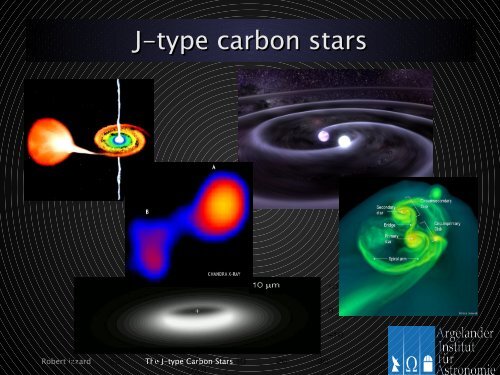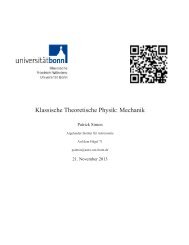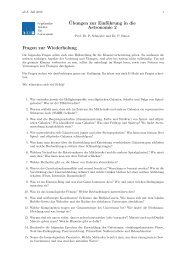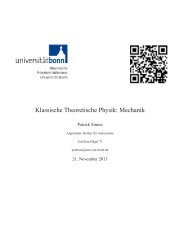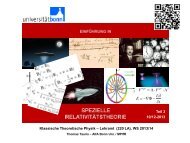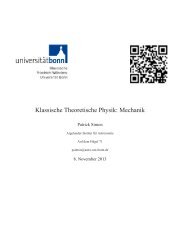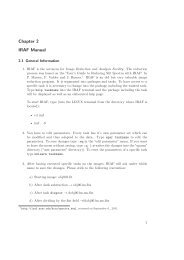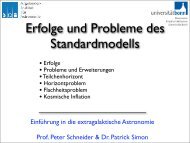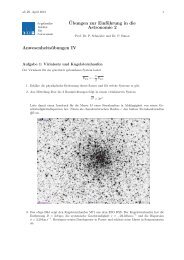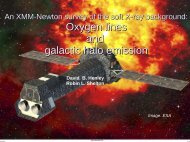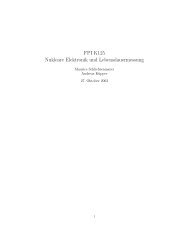Create successful ePaper yourself
Turn your PDF publications into a flip-book with our unique Google optimized e-Paper software.
J-<strong>type</strong> <strong>carbon</strong> <strong>stars</strong><br />
Robert Izzard The J-<strong>type</strong> Carbon Stars
Robert Izzard The J-<strong>type</strong> Carbon Stars<br />
The Carbon Stars<br />
N <strong>stars</strong> : AGB third dredge up<br />
CH/CEMP <strong>stars</strong> : binaries, first ascent giants (N<br />
companion)<br />
R <strong>stars</strong> : mergers? (all single, no sprocess)<br />
J <strong>stars</strong> : no idea at all!<br />
C=O > 1<br />
By number of particles!
Robert Izzard The J-<strong>type</strong> Carbon Stars<br />
N Stars<br />
AGB <strong>stars</strong> : third dredge up<br />
<br />
Te® » 3000 K L & 10 4 L¯<br />
C=O & 1 ¡ 2<br />
sprocess rich (Tc)<br />
Approx. solar metallicity (in MW)<br />
Qualitatively (semiquantitatively) understood<br />
Lots of models!<br />
M ! S ! C<br />
Mbol » ¡8:7 to ¡ 3<br />
MV » ¡2:2
CH and CEMP <strong>stars</strong><br />
(Halo) Binaries (at least CEMPs)<br />
(Diluted) AGB composition<br />
Mass accretion from AGB companion (dead)<br />
Mostly giants MV » ¡1:8 (dwarfs rare, dim)<br />
Halo <strong>stars</strong>, few in Galactic disc, fewer in bulge<br />
Robert Izzard The J-<strong>type</strong> Carbon Stars<br />
Image from Onno Pols
Robert Izzard The J-<strong>type</strong> Carbon Stars<br />
R <strong>stars</strong><br />
All single <strong>stars</strong> : mergers? (popsyn consistent)<br />
C12, C13, N rich, Li?, no sprocess<br />
Subsolar thick disc population<br />
“Low”L (heliumburning <strong>stars</strong>)<br />
I have an old talk on these...<br />
… for another time perhaps!<br />
MV » 0<br />
L » 100 L¯
J Stars: C13-rich C-<strong>stars</strong><br />
Morgan et al 2003 MNRAS 341, 534<br />
Robert Izzard The J-<strong>type</strong> Carbon Stars<br />
Red = C13<br />
A real mystery<br />
among the<br />
<strong>carbon</strong> <strong>stars</strong>
Robert Izzard The J-<strong>type</strong> Carbon Stars<br />
Number statistics<br />
NJ=NC » 10 ¡ 15% in MW and LMC<br />
(Abia & Isern 2000, Morgan et al 2003: 1497 C <strong>stars</strong> in LMC: 156 J <strong>type</strong>)<br />
J <strong>stars</strong> are not rare!<br />
Of which » 15%<br />
are “bright J <strong>stars</strong>” =<br />
AGB <strong>stars</strong> undergoing hotbottom burning<br />
( » 15% £ 15% » 2% of all C <strong>stars</strong> i.e. rare)<br />
Not Mira pulsators (J=irregular/semi regular)
Luminosity Function<br />
Robert Izzard The J-<strong>type</strong> Carbon Stars<br />
Hatzidimitriou et al 2003 MNRAS 341,1290<br />
LMC <strong>stars</strong>
Colour-magnitude<br />
Robert Izzard The J-<strong>type</strong> Carbon Stars<br />
Galactic <strong>stars</strong><br />
Abia and Isern 2000<br />
A&A 536, 438
Bright J Stars = AGB Stars<br />
Robert Izzard The J-<strong>type</strong> Carbon Stars
Bright J Stars = AGB Stars<br />
Robert Izzard The J-<strong>type</strong> Carbon Stars
Bright J Stars = AGB Stars<br />
Robert Izzard The J-<strong>type</strong> Carbon Stars
Bright J Stars = AGB Stars<br />
Robert Izzard The J-<strong>type</strong> Carbon Stars
Bright J Stars = AGB Stars<br />
Robert Izzard The J-<strong>type</strong> Carbon Stars
C13 ratios observed<br />
Ohnaka+Tsuji 1999 A&A 345,233<br />
See also<br />
Harris et al 1987<br />
ApJ 316,294 :<br />
“No form of the CNO cycle,<br />
in any astrophysical site, at<br />
any temperature, can<br />
explain the ratios in J-<strong>type</strong><br />
<strong>carbon</strong> <strong>stars</strong>”<br />
Robert Izzard The J-<strong>type</strong> Carbon Stars
Lithium vs<br />
Robert Izzard The J-<strong>type</strong> Carbon Stars<br />
12 C= 13 C<br />
Galactic <strong>stars</strong><br />
Abia and Isern 2000<br />
A&A 536, 438
Chemistry compared<br />
Star [s/Fe] Tc? Li?<br />
N >1.1 20-100 >1 500-<br />
4000<br />
Robert Izzard The J-<strong>type</strong> Carbon Stars<br />
700-<br />
2400<br />
J >1.1 1-10 5 350-850 150-<br />
1600<br />
Sun<br />
After<br />
1DUP<br />
C<br />
O<br />
12 C<br />
13 C<br />
C<br />
N<br />
+1 to<br />
+2<br />
yes no<br />
0 no Yes<br />
(75%)<br />
0.3 89 4.8 2660 490 0 no no<br />
2 M¯ » 1<br />
16 O<br />
17 O<br />
16 O<br />
18 O<br />
0.3 7-25 300-650 600 0 no no<br />
Compiled by John Lattanzio
Robert Izzard The J-<strong>type</strong> Carbon Stars<br />
Silicate Discs<br />
10% of J <strong>stars</strong> show silicate discs<br />
But … Silicate = oxygen rich!<br />
Binary model, disc is around<br />
The other star or<br />
Both <strong>stars</strong> (Deroo etal 2007 A&A467,1093)<br />
1 yr disc replenishment but<br />
14 yr obs. (Yamamura et al 2000 A&A 363,629)<br />
All silicate C<strong>stars</strong> are J <strong>stars</strong><br />
Si O2<br />
Not all J <strong>stars</strong> have silicates: noneq chemistry?
The J Star Mystery!<br />
Not yet sure how to put all the clues together<br />
Some are HBBing AGB <strong>stars</strong>, some have discs<br />
The others (which are the majority)?<br />
Ideas?<br />
Binary origin? (no binary statistics)<br />
Novae? (A+B grains? Lowmass CO nova?)<br />
Crich supernoave? (no idea about this!)<br />
Heflash mixing? (c.f. R <strong>stars</strong>); Noneq dust chemistry?<br />
AGB models wrong? (always the case! HBB difficult)<br />
Extra mixing (but makes N and C/O


